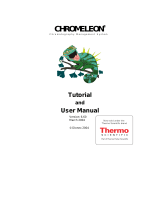
January 2010 Rev. 02 Page i
© 2010 Dionex
Table of Contents
1. Introduction ...................................................................................................................... 1
1.1 How to Use this Manual ............................................................................................. 1
1.2 Definition of LCi ........................................................................................................ 2
1.3 Typical System Setups ............................................................................................... 2
1.3.1 Single-Stack ........................................................................................................... 2
1.3.2 Dual-Stack .............................................................................................................. 3
1.4 Viper Connections ...................................................................................................... 3
1.5 Viper Capillary Kits and Packaging ........................................................................... 5
1.5.1 Capillary Kits for Single Stacks ............................................................................. 5
1.5.2 LCi Capillary Kits .................................................................................................. 7
1.6 Viper Labeling ............................................................................................................ 8
1.7 General System Preparation ....................................................................................... 9
1.8 Connecting the Eluent Line to the Solvent Reservoir ................................................ 9
1.9 Using 10-Port Instead of 6-Port TCC-3x00 Valves ................................................. 11
2. Viper™ Tandem Operation Capillary Kits, Dual-Ternary Standard
(P/N 6040.2804) or Rapid Separation (P/N 6040.2803) ............................................... 13
2.1 Benefits of Tandem Operation ................................................................................. 13
2.2 Scope of Delivery ..................................................................................................... 13
2.3 Stacking the Modules ............................................................................................... 14
2.4 Flow Schematic ........................................................................................................ 15
3. Viper™ Application Switching Capillary Kits, Dual-Ternary Standard
(P/N 6040.2806) or Rapid Separation (P/N 6040.2805) ............................................... 17
3.1 Benefits of Application Switching ........................................................................... 17
3.2 Scope of Delivery ..................................................................................................... 17
3.3 Stacking the Modules ............................................................................................... 18
3.4 Flow Schematic ........................................................................................................ 19
4. Viper™ On-Line SPE Capillary Kits, Dual-Ternary Standard
(P/N 6040.2802) or Rapid Separation (P/N 6040.2801) ............................................... 21
4.1 Benefits of On-line SPE ........................................................................................... 21
4.2 Scope of Delivery ..................................................................................................... 21
4.3 Stacking the Modules ............................................................................................... 22
4.4 Flow Schematic ........................................................................................................ 23
5. Viper™ Parallel LC Capillary Kits, Dual-Ternary Standard
(P/N 6040.2810) or Rapid Separation (P/N 6040.2809) ............................................... 25
5.1 Benefits of Parallel LC ............................................................................................. 25
5.2 Scope of Delivery ..................................................................................................... 25
5.3 Stacking the Modules ............................................................................................... 26
5.4 Flow Schematic ........................................................................................................ 27
6. Viper™ Automated Method Scouting Kits, Quaternary Standard
(P/N 6040.2808) or Rapid Separation (P/N 6040.2807) ............................................... 29
6.1 Benefits of Automated Method Scouting ................................................................. 29
6.2 Scope of Delivery ..................................................................................................... 29
6.2.1 Automated Method Scouting ............................................................................... 29
6.2.2 Extension Kit for Automated Method Scouting (P/N 6040.0100) ....................... 30
6.3 Stacking the Modules ............................................................................................... 31
6.3.1 Single-stack without Extension Kit ...................................................................... 31


























